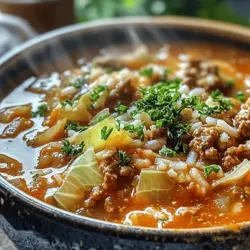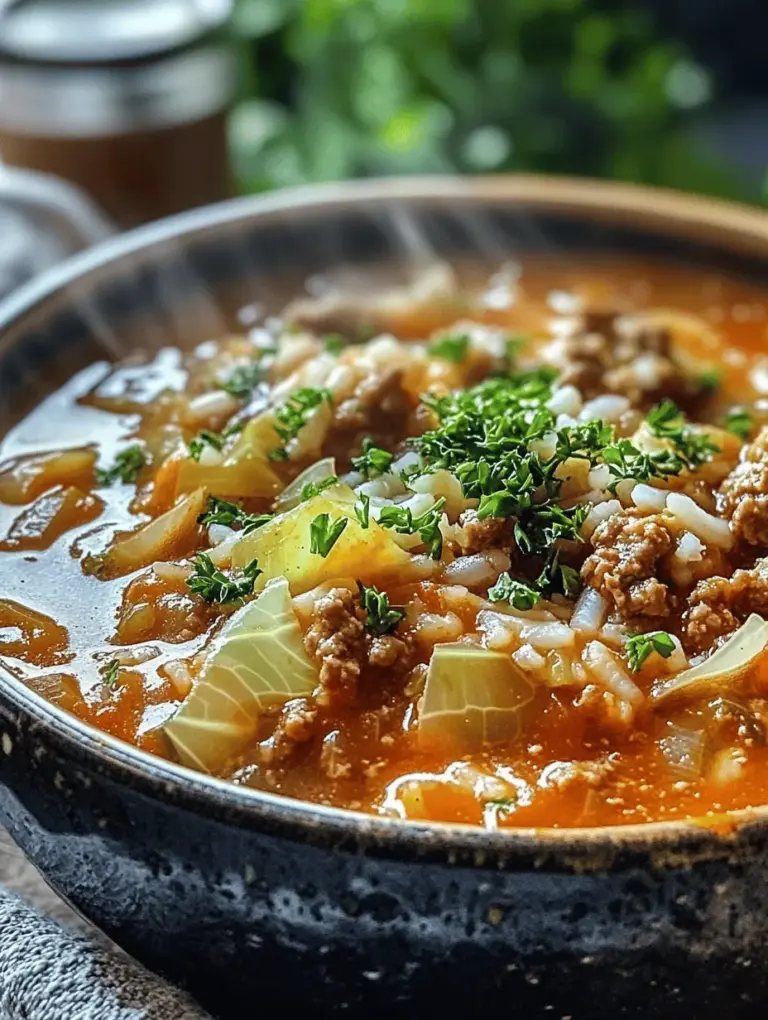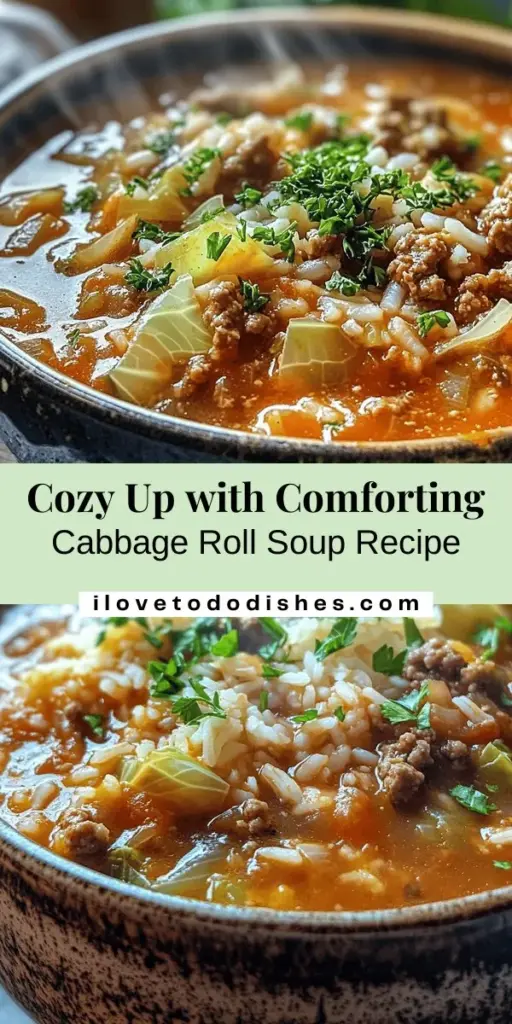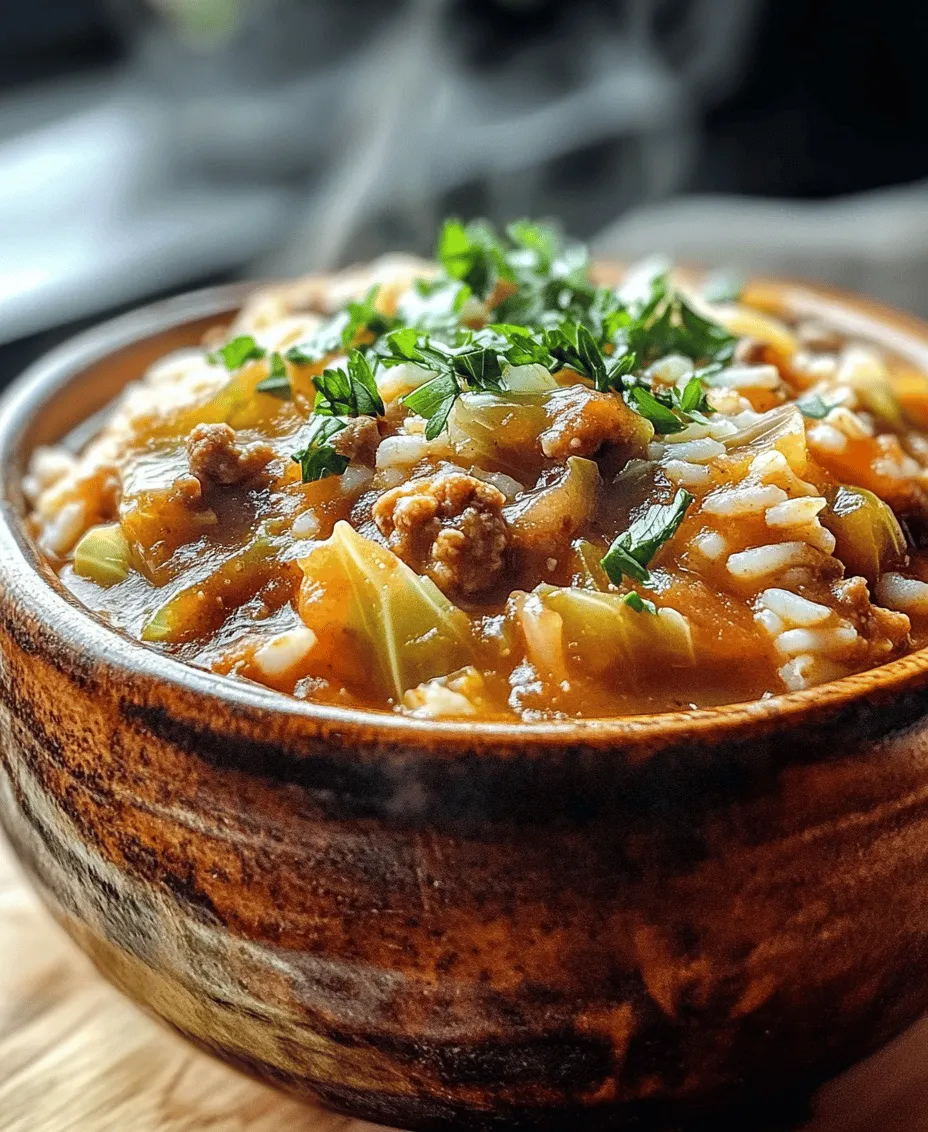Cabbage Roll Soup is a dish that encapsulates comfort in every spoonful. With its hearty blend of vegetables, meat, and grains, this soup offers a warm embrace on chilly days, making it a beloved choice for families and individuals alike. The rich flavors and aromatic spices create a dish that not only satisfies hunger but also evokes feelings of nostalgia and warmth. As we delve into this recipe, we will explore its cultural significance, ingredients, and the comforting essence that makes Cabbage Roll Soup a staple in many households.
Understanding Cabbage Roll Soup
What is Cabbage Roll Soup?
At its core, Cabbage Roll Soup is a deconstructed version of traditional cabbage rolls, where cabbage leaves are typically stuffed with a mixture of meat and rice, then rolled and cooked in tomato sauce. This soup takes the same delightful flavors and combines them into a warm, hearty bowl. Often, it features ground meat, fresh cabbage, and aromatic vegetables simmered in a rich broth, resulting in a nutritious and satisfying meal.
Origins and Traditional Variations
Cabbage Roll Soup has roots in various cuisines, particularly in Eastern European countries such as Poland, Hungary, and Russia. Each culture has its unique twist on the dish, incorporating local ingredients and cooking methods. For example, Polish golabki, or stuffed cabbage rolls, are popular during family gatherings and festive occasions. In Hungary, the dish might be spiced with paprika to give it a distinctive flavor. Despite these variations, the essence of Cabbage Roll Soup remains the same: it brings people together, providing warmth and nourishment.
Nutritional Benefits
Cabbage, the star ingredient in this soup, is packed with essential nutrients. It’s low in calories yet rich in vitamins C and K, fiber, and antioxidants, making it an excellent choice for maintaining overall health. The addition of other vegetables, such as onions and garlic, not only enhances the flavor but also contributes additional health benefits, such as improved immune function and digestion. Depending on your choice of meat, you can also infuse the soup with protein, making it a well-rounded meal.
Why Choose Soup for Comfort?
Soup has a unique way of comforting both the body and the mind. Whether it’s the soothing warmth of the broth or the familiar flavors that remind us of home, a bowl of soup can lift our spirits, especially during tough times. Comfort food, like Cabbage Roll Soup, plays a vital role in our emotional well-being, often evoking cherished memories associated with family gatherings or cozy nights in. Furthermore, homemade soups typically contain wholesome ingredients and can be tailored to individual tastes, promoting a healthier lifestyle.
Ingredients Breakdown
To create a delicious and comforting Cabbage Roll Soup, it’s essential to gather the right ingredients. Each component plays a crucial role in developing the flavor profile and nutritional value of the dish.
Fresh Produce
Cabbage: The foundation of this soup, fresh cabbage adds texture and nutrition. When selecting cabbage, look for heads that are firm and heavy with tightly packed leaves. Not only does cabbage provide a pleasant crunch, but it is also a powerhouse of vitamins and minerals, making it a healthy addition to any meal.
Onions and Garlic: These aromatics are essential for flavor enhancement. Onions add sweetness and depth to the soup, while garlic contributes a savory and pungent note. Together, they create a fragrant base that elevates the overall taste of the dish.
Meat Options
When it comes to the meat in your Cabbage Roll Soup, you have a couple of popular choices: ground beef or ground turkey.
Ground Beef: This classic option offers a rich, hearty flavor, making the soup more filling. It’s also higher in fat, which can add to the overall richness of the broth.
Ground Turkey: For a lighter alternative, ground turkey is an excellent choice. It provides a leaner protein option that is lower in calories and saturated fat, making it a healthier alternative without sacrificing flavor.
The Importance of Broths and Tomatoes
The choice of broth significantly impacts the flavor and nutrition of your soup. A rich beef or chicken broth can add depth, while vegetable broth offers a lighter base.
Crushed Tomatoes and Tomato Paste: These ingredients are crucial for building the soup’s base. Crushed tomatoes provide acidity and sweetness, balancing the flavors, while tomato paste adds intensity and richness. Together, they create a robust sauce that envelops the cabbage and meat.
Herbs and Spices
To round out the flavor profile of your Cabbage Roll Soup, herbs and spices are essential.
Oregano and Basil: Both herbs are classic choices that complement the tomato base beautifully. Oregano brings a warm, earthy flavor, while basil adds a sweet, aromatic note.
When seasoning, it’s crucial to find the right balance. Start with a small amount of each herb, and adjust according to your taste preferences. Fresh herbs can also be used for a more vibrant flavor.
Step-by-Step Cooking Instructions
Now that we have a solid understanding of the ingredients, let’s dive into the preparation of this comforting dish, starting with the aromatics.
Preparing the Aromatics: Sautéing Onion and Garlic
1. Heat the Oil: Begin by heating a tablespoon of olive oil in a large pot or Dutch oven over medium heat. Allow the oil to warm up, which should take about a minute.
2. Sauté the Onion: Once the oil is hot, add a finely chopped onion to the pot. Stir occasionally, cooking the onion until it becomes translucent and fragrant, typically about 5 minutes. This process releases the onion’s natural sweetness, forming a flavorful base for your soup.
3. Add Garlic: After the onion has softened, add minced garlic to the pot. Sauté for an additional minute until the garlic becomes fragrant, being careful not to let it burn. Burnt garlic can impart a bitter flavor, so keep an eye on it.
4. Combine with Ground Meat: Next, add your choice of ground meat to the pot. Break it apart with a wooden spoon, mixing it with the onions and garlic. Cook until the meat is browned and fully cooked through, which should take about 5-7 minutes.
5. Season the Mixture: As the meat cooks, season with salt, pepper, and a pinch of oregano. This will allow the spices to infuse the meat and aromatics, enhancing the overall flavor of the soup.
By following these initial steps, you’ll have a flavorful base for your Cabbage Roll Soup, setting the stage for the addition of the remaining ingredients. As we continue with this recipe, the comforting aroma of sautéed onions and garlic will beckon you to the kitchen, inviting you to enjoy the process of creating a dish that warms both body and soul.
Stay tuned for the next part where we’ll incorporate the fresh cabbage, tomatoes, and broth, bringing this comforting dish to life, and explore further steps in creating the ultimate Cabbage Roll Soup.
Developing Flavors from the Start
The foundation of a great soup lies in the development of flavors right from the beginning. When you start cooking, particularly with dishes like Comforting Cabbage Roll Soup, it’s essential to take your time to build a depth of flavor that will elevate the entire dish. This means paying attention to the meat and vegetables you add at the outset.
Browning the Meat: Techniques for Flavor
Browning the meat is a crucial step in this process. This technique not only enhances the flavor but also adds a rich color to the soup. To achieve the best browning, use a heavy-bottomed pot or Dutch oven that retains heat well. Heat the pot over medium-high heat and add a small amount of oil. Once the oil is shimmering, add your ground meat.
Tips for Achieving Perfect Browning:
1. Don’t Overcrowd the Pan: Adding too much meat at once can lower the pan’s temperature, resulting in steaming rather than browning. Work in batches if necessary.
2. Let it Sit: Allow the meat to sear without stirring for a few minutes. This will create a nice crust that enhances flavor.
3. Drain Excess Fat: After browning, you may want to drain some of the fat to prevent the soup from becoming greasy. This can be done by tilting the pot slightly and using a spoon to remove the excess fat.
Incorporating Cabbage: Wilting Techniques
When it comes to cabbage, proper cooking techniques are key for optimal texture in your soup. Start by chopping the cabbage into bite-sized pieces.
To wilt the cabbage:
1. Add After Browning: Once your meat is browned and drained, add the chopped cabbage directly to the pot.
2. Sauté Briefly: Stir the cabbage in with the meat for a few minutes until it starts to soften. This helps to merge the flavors.
Combining Ingredients: Building the Soup Base
Now that your meat and cabbage are ready, it’s time to build the soup base. Start by adding your chopped onions, garlic, and bell peppers. These aromatics are essential for layering the flavors in your soup.
When adding liquids:
1. Layering Flavors: Begin with broth or stock, then add crushed tomatoes, tomato paste, and any other liquids specified in your recipe.
2. Utilize the Browning Bits: When you add the liquids, scrape the bottom of the pot to release any flavorful bits left from the browning process. This adds even more depth to your soup.
Cooking the Rice: Timing and Techniques
If your recipe includes rice, cooking it properly is essential for achieving the right texture.
1. Use the Right Type of Rice: Long-grain rice works best as it cooks evenly and doesn’t become mushy.
2. Add at the Right Time: Add the rice to the soup after the liquid has been incorporated and is boiling. This allows the rice to absorb the flavors from the soup while cooking.
Simmering: The Heart of the Soup
Simmering is where the magic happens. Once all ingredients are in the pot, bring the soup to a gentle boil before reducing the heat to a simmer.
1. Flavor Development: Allow the soup to simmer for at least 30 minutes. This lets the flavors meld together beautifully, deepening the taste of the soup.
2. Tenderness of Ingredients: Keep an eye on the cabbage and meat; they should become tender but not overcooked. Stir occasionally to ensure even cooking.
Final Adjustments: Tasting and Seasoning
As your soup nears completion, tasting and adjusting the seasoning is crucial.
1. Taste Throughout: Start tasting the soup after about 20 minutes of simmering. This will help you gauge the flavors and adjust as necessary.
2. Seasoning: Add salt, pepper, and any additional herbs or spices to enhance the flavor. Fresh herbs like dill or parsley can add a wonderful burst of freshness right before serving.
Serving Suggestions
Presentation Tips for a Beautiful Bowl of Soup
When serving Comforting Cabbage Roll Soup, presentation can elevate the dining experience.
1. Use a Deep Bowl: A deep bowl will hold the soup and look inviting.
2. Layered Look: Try to showcase the cabbage, rice, and meat in a visually appealing way.
Ideas for Garnishing with Fresh Parsley
A sprinkle of fresh parsley not only adds color but also freshness. Chop the parsley finely and sprinkle it over the top just before serving.
Ideal Pairings with Comforting Cabbage Roll Soup
This soup is hearty and satisfying on its own but can be paired with several sides to make a complete meal:
1. Crusty Bread: Serve with a side of crusty bread for dipping. A good sourdough or whole-grain bread complements the flavors well.
2. Salad: A light salad with vinaigrette can provide a refreshing contrast to the rich soup.
Storing and Reheating Leftovers
If you have leftovers, here are some best practices for preserving flavor and texture:
1. Cool Before Storing: Allow the soup to cool before transferring it to an airtight container. This helps prevent condensation from watering down the soup.
2. Refrigeration: Store in the refrigerator for up to three days. For longer storage, consider freezing the soup.
To reheat, use a stovetop pot over medium heat, stirring occasionally until heated through. If the soup thickens too much after refrigeration, simply add a splash of broth or water during reheating.
Nutritional Analysis
Breakdown of Calories and Nutrients per Serving
Comforting Cabbage Roll Soup is not only delicious but also nutritious. A typical serving contains approximately:
– Calories: 300
– Protein: 20g
– Carbohydrates: 35g
– Fiber: 6g
– Fat: 10g
These values can vary based on the specific ingredients used and portion sizes.
Health Benefits of the Main Ingredients
– Cabbage: Rich in vitamins C and K, cabbage is a low-calorie vegetable that supports digestion and may reduce inflammation.
– Ground Meat: Provides essential proteins and vitamins, particularly if using lean varieties.
– Rice: A good source of carbohydrates, offering energy and fiber, particularly if you use whole grain.
Dietary Considerations
This soup can be easily adapted for various dietary needs. To make it gluten-free, ensure you use gluten-free rice and broth. For a low-carb option, consider substituting rice with cauliflower rice.
Conclusion
Comforting Cabbage Roll Soup is a heartwarming dish that embodies the essence of cozy meals. Its rich flavors, combined with the health benefits of its ingredients, make it an ideal choice for family gatherings or a quiet night at home.
Encouraging you to make this dish a staple for your cozy meals, it’s versatile enough to become part of your family traditions. Whether enjoyed on a chilly day or served at a holiday gathering, this soup promises warmth and satisfaction in every bowl. So gather your ingredients and enjoy the process of creating a dish that brings comfort and joy to your table.



